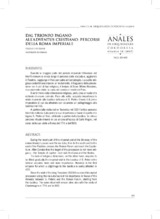Dal trionfo pagano all'adventus crisitano: percorsi della Roma Imperiale

Ver/
Autor
Liverani, Paolo
Editor
Universidad de Córdoba, Área de ArqueologíaFecha
2007Materia
Roma ImperialeTrionfo pagano
Adventus cristiano
METS:
Mostrar el registro METSPREMIS:
Mostrar el registro PREMISMetadatos
Mostrar el registro completo del ítemResumen
Durante la maggior parte del periodo imperiale l’itinerario del trionfo romano si snoda lungo il percorso della via Lata e, aggirando il Palatino, raggiunge il Foro per salire al Campidoglio. La svolta religiosa costantiniana impone un mutamento: il traguardo della processione non è più di tipo religioso, il tempio di Giove Ottimo Massimo, ma solamente civile: la curia del senato e i rostri del Foro. Il venir meno della dimensione religiosa, però, crea un vuoto che richiede di essere colmato. Poco alla volta, acquista importanza la visita imperiale alla basilica Vaticana di S. Pietro. Onorio è il primo imperatore di cui sia attestato con sicurezza un pellegrinaggio alla basilica nel 403. A partire dalla visita del re Teodorico nel 500 l’antico percorso trionfale della via Lata perde la sua importanza a favore di quello che legava S. Pietro al Foro, utilizzato a partire dalla basilica. Lo stesso percorso rituale rimarrà in uso ancora all’epoca di Carlo Magno, nel corso delle sue visite a Roma del 774 e dell’800. During the most part of the imperial period the itinerary of the roman triumph passes over the via Lata, then to the south and to the east of the Palatine, crosses the Roman Forum and reach the Capitolium. After Constantine the target of the procession is not more religious – the Temple of Jupiter – but civil: the Curia and the Rostra. The lack of religious dimension, on the other hand, requires to be fi lled: gradually the imperial visit to the basilica of S. Peter in the Vatican acquires more and more importance. Honorius is the fi rst emperor for whom a pilgrimage to the basilica is surely attested in 403. Since the visit of the king Theodoric (500) the ancient triumphal procession along the via Lata has lost his importance in favour of the itinerary between S. Peter’s and the Roman Forum, starting from the basilica. The same ritual will remain alive also with the visits of Charlemagne in 774 and in 800.
